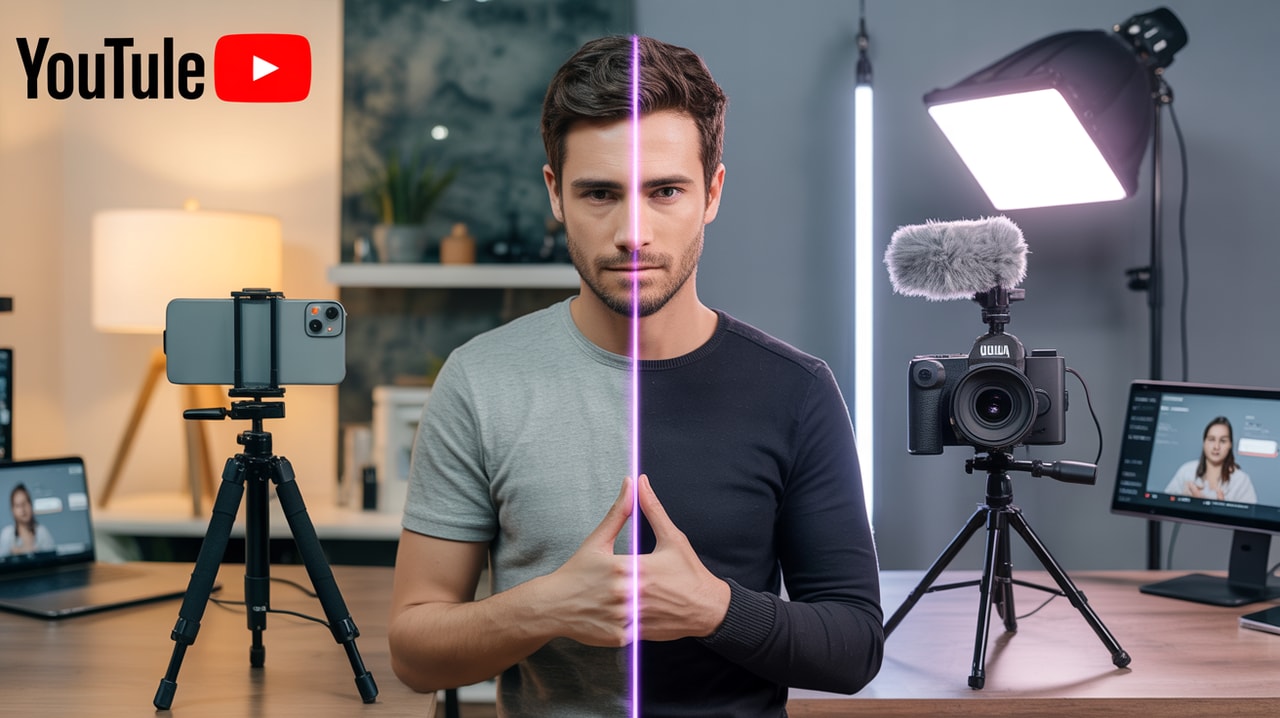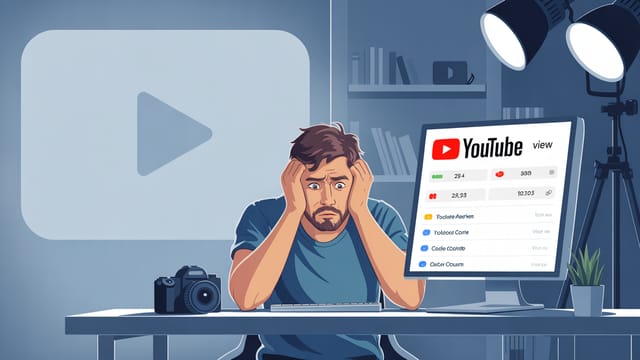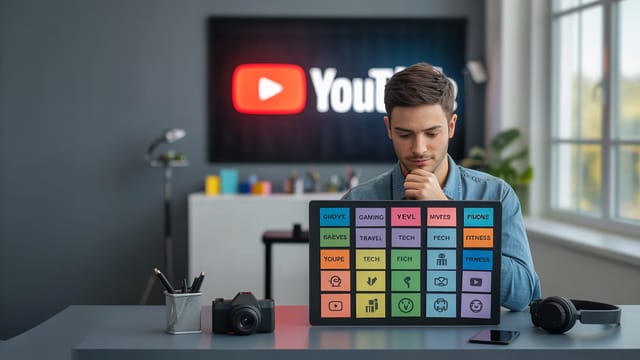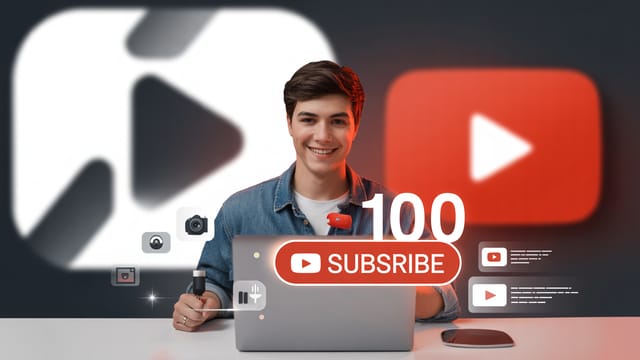
Ready to get your next 10,000 subscribers?
Join thousands of creators who use Subscribr to create faster, better YouTube videos.
How Your YouTube Filming Setup Evolves (From Beginner to Pro)
Starting a YouTube channel is exciting, but as you grow, you might look at successful creators and wonder, "When do I need to upgrade my gear? What equipment even comes next?" The uncertainty of knowing when and what to invest in can be a major pain point, often leading to fear of buying the wrong things or equipment that quickly becomes obsolete.
The truth is, your YouTube filming setup isn't a one-time purchase; it's a journey that evolves alongside your channel. Think of it as providing a better and better viewing experience as your audience grows and your content demands change. This article will map out the typical progression of a YouTube production setup, helping you anticipate future needs, make smart investments, and avoid that fear of obsolescence.
Understanding this roadmap will help you justify upgrades, see the potential ROI of your gear, and optimize your filming space as you move from making videos on your phone to potentially building a dedicated studio.
Stage 1: The Bare Essentials (Getting Started)
Every creator starts somewhere, and for many, that's with the gear they already own. The absolute beginner setup is about minimizing barriers to entry and focusing entirely on the content itself.
At this stage, your setup likely includes:
- A Smartphone or Basic Webcam: Modern smartphones have incredible cameras capable of shooting in HD or even 4K. A built-in laptop webcam can also work for certain formats.
- Natural Light: Positioning yourself near a window is the cheapest and often most flattering light source.
- Built-in Microphone: Using the microphone on your phone, webcam, or laptop.
- A Simple Background: A clean wall, a tidy corner of your room, or even just a blurred background works.
Key Focus at This Stage: Can people see and hear you clearly enough? Is your message coming across effectively? As insights from the youtube_strategy tool highlight, simply meeting the "acceptable quality within your niche" is sufficient to start. For many commentary or educational formats, basic quality is perfectly acceptable if the information is valuable. Don't get hung up on needing fancy gear; focus on creating compelling content that resonates.
The goal here is consistency and building a habit. Don't let gear limitations stop you from starting.
Stage 2: Leveling Up the Essentials (Improving Viewer Experience)
Once you've found your rhythm and started to get some initial traction, the limitations of basic equipment might become apparent. Viewers might mention audio quality issues or inconsistent lighting. This is the time to make targeted upgrades that significantly improve the viewer experience, which is crucial for audience retention.
Typical upgrades in Stage 2 include:
- A Dedicated Microphone: This is often the most impactful first upgrade. Poor audio can make even great video unwatchable. Options range from affordable USB microphones ($80-$200) that plug directly into your computer to simple lavalier mics that clip onto your shirt. According to
youtube_strategyinsights, you can get a decent mic comparable to those used by channels with 10k to 1M+ subscribers for a few hundred dollars. - Basic Artificial Lighting: Relying solely on natural light means you can only film at certain times. Adding a simple ring light or a small LED panel provides consistent, controllable light. A single light costing around $300 combined with a softbox around $150 can achieve competitive quality. This helps eliminate distracting shadows and ensures a consistent look across your videos.
- An Entry-Level Camera or Mirrorless Camera: While not always necessary right after audio/lighting, upgrading from a webcam or phone can offer better image quality, depth of field (that blurry background look), and more control. Cameras like the Canon M50 (older but popular entry point) or newer mirrorless options are common first camera upgrades.
- A Sturdy Tripod: To keep your shots stable and consistent.
Justification & ROI: These upgrades directly address the most common viewer complaints (audio/video quality). Better quality keeps viewers watching longer, improving audience retention signals to YouTube, and making your content more shareable. The ROI is seen in improved engagement metrics and subscriber growth.
Stage 3: Building a Consistent Filming Space (Elevating Your Brand)
As your channel grows (perhaps reaching the 10k-100k subscriber range like some of the tech review channels found in the search), you'll likely benefit from having a dedicated space for filming. This allows for a consistent background, better control over lighting and sound, and a more professional "look" that reinforces your brand.
Setup elements for Stage 3:
- Designated Filming Area: This could be a corner of a room, a dedicated desk setup, or even a small closet treated for sound.
- Improved Background/Set: Adding simple decorations, shelving, or using a collapsible backdrop to create a visually appealing and consistent background.
- Acoustic Treatment: Basic acoustic foam panels or even just soft furnishings (rugs, blankets) can significantly reduce echo and improve audio quality in your dedicated space.
- More Refined Lighting Setup: Moving beyond a single light to a two or three-point lighting setup (key light, fill light, backlight) for more dimension and professional look. Using larger softboxes for softer light.
- Cable Management: Keeping cables tidy not only looks better but prevents accidents and simplifies setup time.
Justification & ROI: A consistent filming space elevates your brand's perceived professionalism. It makes your channel look more established and reliable. This consistency builds trust with your audience. It also streamlines your workflow, as you don't have to set up and tear down gear for every video.
চ্যানেলের মতো @Tech Ai (10.6K subscribers) বা @Typical Tech Lad (9.21K subscribers) তাদের বিষয়বস্তুর জন্য একটি পরিষ্কার, সুসংগত পটভূমি এবং পর্যাপ্ত আলো ব্যবহার করে তাদের ব্র্যান্ড তৈরি করে।
Stage 4: Investing in Workflow & Quality (Scaling Production)
Hitting significant milestones (like 100k+ subscribers, similar to filmmaking channels such as @Mark Bone with 347K subscribers or @Premiere Basics with 566K subscribers) often means you're producing more content and potentially exploring new formats. At this stage, gear upgrades are often focused on efficiency, higher quality, and enabling more complex shots or editing.
Upgrades may include:
- Faster Computer: Editing high-resolution video takes processing power. Upgrading your computer can drastically cut down on editing and export times – a key point noted by
youtube_strategyinsights, emphasizing that saving time is saving money. - Higher-End Camera & Lenses: Investing in a camera with better low-light performance, higher frame rates (for slow-motion), or external recording capabilities. Acquiring different lenses (e.g., a wide-angle for vlogging, a prime lens for interviews) to achieve specific visual styles.
- More Advanced Audio Gear: Moving to XLR microphones requiring an audio interface, or wireless microphone systems for filming further from the camera or doing on-the-go content.
- Specialty Lighting: Adding practical lights to your set (lamps, LED strips) or investing in more powerful, color-accurate lights.
- Camera Accessories: Sliders, gimbals, or drones to add dynamic movement to your videos.
Justification & ROI: These investments are about scaling your production. Faster workflow means you can create more content or spend more time on other aspects like strategy and optimization. Higher quality gear can unlock new creative possibilities and further refine your channel's aesthetic, justifying the investment through enhanced production value that aligns with audience expectations at this scale. This is where reinvesting channel revenue back into the business becomes a common practice.
Stage 5: The Professional Studio (Mastering Your Craft)
At the highest levels (multi-million subscriber channels like those found in the vlog search, such as @TFG Vlogs with 1.24M subscribers or @Valkyrae with 4.08M subscribers, or major tech reviewers like MKBHD whose studio was toured in one of the searched videos), a YouTube setup can resemble a professional broadcast studio. This stage is about maximizing efficiency, achieving the highest possible quality, and having specialized gear for every conceivable need.
Elements of a professional setup:
- Dedicated Studio Space: A soundproofed, acoustically treated room or even a purpose-built studio building.
- Advanced Lighting Systems: Permanent, complex lighting grids with multiple lights, modifiers, and control systems.
- Multiple Cameras: Having several cameras set up for different angles simultaneously, speeding up filming and editing.
- High-End Cinema Cameras: Investing in cameras used in film and television production for the ultimate image quality.
- Professional Audio Mixing: Using a mixer board and multiple high-quality microphones.
- Teleprompter: For delivering scripts smoothly and maintaining eye contact.
- Control Room Setup: Monitors, switchers, and recording equipment for managing complex shoots.
Justification & ROI: At this level, the setup is a critical part of a large-scale media operation. The ROI is less about direct subscriber growth from a single upgrade and more about maintaining production volume, enabling high-level collaborations, and supporting a full-time content business. Studio tours from channels like Think Media or Peter McKinnon, or the tour of MKBHD's setup, showcase the scale and specialization involved at this stage.
Justifying Upgrades and Overcoming Fear of Obsolescence
The fear of upgrading only to have gear become outdated is understandable. However, viewing your setup as an evolving system, rather than a collection of static items, helps mitigate this.
- Phased Investment: You don't need to buy everything at once. Follow the progression: master Stage 1 before investing heavily in Stage 2, and so on. This allows you to spread costs and ensure each purchase is justified by your current needs and growth stage.
- Focus on Foundational Gear: Good microphones, versatile lights, and sturdy tripods have long lifespans and retain value. Invest in quality basics first.
- Gear as a Tool for Content: Ask yourself, "Will this upgrade allow me to create new types of content, improve the quality of my existing content in a meaningful way, or significantly speed up my workflow?" If the answer is yes, it's likely a worthwhile investment.
- Budgeting and ROI: As you grow, consider setting aside a portion of your YouTube revenue specifically for reinvesting in equipment. Think of gear as a business expense that enables future earnings. For intermediate creators, exploring affiliate marketing for the gear you use and recommend can also help offset costs and even become a monetization stream, directly linking your setup to revenue.
- Don't Chase Trends: Avoid buying the latest, most expensive gear just because it's new. Upgrade when your current equipment is genuinely holding you back or when a new piece of gear offers a clear, practical benefit to your specific content and workflow.
Beyond Gear: Skills, Strategy, and Subscribr
While upgrading your physical setup is part of the journey, it's crucial to remember that gear is only one piece of the puzzle. As the youtube_strategy tool emphasizes, content value is paramount.
Continuously improving your skills in areas like lighting techniques, audio mixing, editing, storytelling, and on-camera presence will often have a greater impact than a camera upgrade.
This is where strategy and understanding your audience become essential. Instead of just focusing on production value, analyze what truly resonates with your viewers. Tools like Subscribr can provide the strategic intelligence you need:
- Utilize Subscribr's Channel Intelligence and Research Assistant to analyze successful channels in your niche and understand the performance patterns of videos (identifying "outliers" that performed exceptionally well). This helps you refine your content ideas and strategy, ensuring you're making videos people want to watch, regardless of your setup.
- Leverage Subscribr's Script Building Pipeline to structure your thoughts and write engaging scripts that keep viewers hooked, maximizing audience retention.
- Use Subscribr's Content Strategy Analysis to identify content gaps and opportunities within your niche, guiding your production efforts effectively.
By focusing on both improving your production setup and refining your content strategy with tools like Subscribr, you build a sustainable path for channel growth.
Conclusion
The evolution of your YouTube filming setup is a natural part of the creator journey. You start simple, focus on content, and gradually invest in gear that improves viewer experience, elevates your brand, increases efficiency, and enables new creative possibilities.
Don't feel pressured to have a perfect setup from day one. Follow this roadmap, make thoughtful investments based on your channel's needs and growth stage, and remember that the most important elements are valuable content and a genuine connection with your audience. By strategically upgrading your gear and continuously improving your skills and strategy, you'll be well-equipped to continue growing on YouTube.





